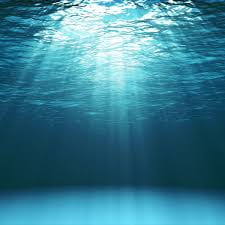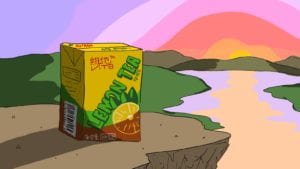
By Abby Gweon
Covering more than 70% of Earth’s surface, the ocean is still, for the most part, a great mystery. 95% of it is completely unexplored and uncharted territory, making our understanding of the planet fairly limited despite our familiarity with every inch of land. All of the continents combined would still be smaller than the Pacific Ocean (NOAA). And while we’ve sailed and flown across the oceans for centuries, we’ve only recently developed the technology to see the deep oceans, a place once thought to be a lifeless void. Here is what we know about the realm below, teeming with life, hidden right beneath our noses.
At 200 meters below the surface, sunlight begins to wane, and we enter an area called the Twilight Zone. The pressure here becomes intolerable for humans, with diver Ahmed Gabr setting a record at 332 meters for the deepest scuba dive (Agarwal). Bioluminescence, or chemical reactions that create light, are used by 90% of the species in this zone to attract prey or to hide from predators. Living here are Sea Angels–translucent, jelly-like sea slugs that propel themselves with wings–Giant Pacific Octopi, swordfish, and sperm whales. Many animals in the Twilight Zone migrate daily to and from the surface, swimming hundreds of feet every night to find food above before returning to the darkness below at daybreak. This is the largest animal migration on the planet, and happens every 24 hours. (Woods Hole Oceanographic Institution)
The Midnight Zone begins at 1,000 meters below the surface, and looks like an endless black abyss, almost like outer space–no light can reach here, but animals still manage to live. The anglerfish of Finding Nemo fame uses a bioluminescent lure to attract prey in range of its fang-like teeth. Giant tube worms live on hydrothermal vents, or hot openings in the seafloor. The orange roughy fish grows here at a very slow rate, and can live to be 200 years old. The animals at these depths must conserve energy because of the lack of resources, and can go for long periods of time without food. These conditions also have an effect on their size, with several animals being much larger than they would be on the surface–the giant isopod can grow to be 19 inches long, huge compared to the average 5-centimeter creature, and can go five years without eating (Agarwhal). Giant squid and giant tube worms are other examples of this effect.
The Abyssal Zone starts at 4,000 meters deep. Here, animals must survive severe, near-freezing temperatures and extreme pressure. The rare megamouth shark, up to 7 meters long, filter feeds on plankton here with its large, circular mouth. The slow-moving abyssal fish tend to feed on suspended matter or mud, and may be blind. (Encyclopaedia Britannica)
More humans have visited the moon than the Hadal Zone at 6,000 meters deep. Most of this zone is in trenches, and little is known about life at these depths. The Mariana Trench was explored for the first time on January 23, 1960, by Jacques Piccard and Don Walsh. Despite the deadly pressure cracking one of the submarine’s windows, they continued to the bottom, becoming the first people to reach the Challenger Deep, the deepest known point in the ocean at 11,000 meters below the surface (Agarwal). Were their submarine to break, they would feel the pressure of 1,086 bar–the equivalent of the weight of around 1,800 elephants (Kurzgesagt)–and become “red puddles of mush,” in Don Walsh’s words, according to The Telegraph. Despite this, animals still thrive down here: sea cucumbers, snailfish, amphipods, and eels call this inhospitable environment home.
But even here at the deepest place on the planet, plastic debris was found in 2018, 10,898 meters below the surface. According to the Marine Policy report, deep-sea pollution was found in six oceanic regions, including the Pacific and Atlantic, at least 1,000 kilometers away from the mainland and up to more than 4,000 meters deep. Most of the items were single-use plastic, and deep-sea organisms were found attached to or entangled in the plastics. (MP Report)
With the surface waters overfished, deep-sea fishing has become common, also contributing to the human footprint left on the depths of the ocean. When deep-sea fish are pulled rapidly to the surface, their cell membranes ooze internally, their swim bladders swell, and they usually die due to the change in pressure (Kunzig). The adaptations that allow them to miraculously survive in the depths make the surface intolerable, much like how the deep waters are dangerous for us. Deep-sea mining further exploits the marine environment for the retrieval of mineral deposits, causing light-pollution, noise and vibrations, sediment plumes, and the destruction of deep-sea habitats that affect the animals and ecosystems living there (IUCN).
With only 5% of the ocean explored, there is still an endless amount of discoveries to be made in the underbelly of the ocean. The deep-sea animals we know of seem like creatures out of a science-fiction movie, with transparent wings, glowing heads, and supersized bodies, and the deep sea is vital to the survival of several million of these remarkable species. Mostly unseen by the human eye, there is much to learn by diving further into Earth’s last frontier, and many to help by preserving it.
Sources:
National Oceanic Atmosphere Administration
https://oceanservice.noaa.gov/facts/exploration.html
https://oceanexplorer.noaa.gov/facts/pacific-size.html
https://www.livescience.com/14493-ocean-exploration-deep-sea-diving.html
Woods Hole Oceanographic Institution
https://www.whoi.edu/know-your-ocean/ocean-topics/ocean-life/ocean-twilight-zone/
Kursgesagt — In a Nutshell
https://sites.google.com/view/sources-deep-sea/
Neal Agarwal
Sea and Sky, “Deep Sea Anglerfish”
http://www.seasky.org/deep-sea/anglerfish.html
National Geographic, “Anglerfish”
https://www.nationalgeographic.com/animals/fish/group/anglerfish/
Wikipedia, “Giant isopod”
https://en.wikipedia.org/wiki/Giant_isopod
Oceana, “Megamouth Shark”
https://oceana.org/marine-life/sharks-rays/megamouth-shark
Encyclopaedia Britannica, “Abyssal Zone”
https://www.britannica.com/science/abyssal-zone
India Sturgis, The Telegraph, “The true story behind the deepest dive in history”
https://www.telegraph.co.uk/men/the-filter/true-story-behind-deepest-dive-history/
Marine Policy Report, “Human footprint in the abyss: 30 year records of deep-sea plastic debris”
https://doi.org/10.1016/j.marpol.2018.03.022
Robert Kunzig, Discover, “The Physics of… Deep-sea Animals”
https://www.discovermagazine.com/the-sciences/the-physics-of-deep-sea-animals
International Union for Conservation of Nature, “Deep-sea mining”
https://www.iucn.org/resources/issues-briefs/deep-sea-mining
Mariana Trench Debris Don Walsh & Jacques Piccard



